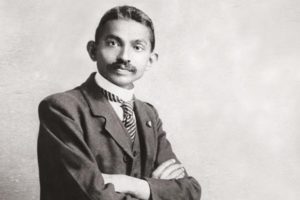Gandhi is well known as the inspiration for Dr. Martin Luther King’s nonviolent resistance and direct action. Nelson Mandela even praised him for helping to pave a way for a non-racial South Africa. Not nearly as well known, however, are the statements and sentiments of the Indian leader regarding African people.
According to a new book, The South African Gandhi: Stretcher-Bearer of Empire, Mohandas Karamchand says Gandhi was a racist who harbored a disdain for Africans. The authors, Ashwin Desai, professor in the Department of Sociology at the University of Johannesburg, and Goolem Vahed, associate professor in the History, Society, and Social Change Cluster of the University of KwaZulu-Natal, quote statements from Gandhi to paint a picture of the man in South Africa before his return to India.
Apparently, Gandhi not only expressed racist attitudes towards Africans and classist prejudice towards indentured Indians, but he also supported the British Empire as a loyal servant, and the use of war by the Imperial Army to further its goals, the book argues.
“He served as stretcher-bearer in the war between Brit and Boer, demanded that Indians be allowed to carry fire-arms, and recruited volunteers for the imperial army in both England and India during the First World War,” the authors said.
The South African Gandhi reveals a figure who, between 1893 and 1914, sought inclusion of Indians into South African society and the exclusion of Blacks—a departure from the image of benevolence with which he is portrayed today.
As the Washington Post reported, the book characterizes Gandhi as one who called Black Africans “savage,” and said they lived a life of “indolence and nakedness.” He attempted to prove to the British that Indians in South Africa were superior to Black Africans, who he called the derogatory term, Kaffir.
For example, Gandhi resented that Indians were classified as “Natives” with Black Africans.
“We felt the indignity too much and … petitioned the authorities to do away with the invidious distinction, and they have now provided three separate entrances for natives, Asiatics and Europeans,” he wrote.
While delivering a speech in Bombay, now Mumbai, in 1896, the Indian leader said that Europeans in Natal wanted “to degrade us to the level of the raw kaffir whose occupation is hunting, and whose sole ambition is to collect a certain number of cattle to buy a wife with, and then, pass his life in indolence and nakedness.”
In 1908, Gandhi expounded on his views while detailing his experience in prison.
“We were marched off to a prison intended for Kaffirs… our garments were stamped with the letter “N”, which meant that we were being classed with the Natives,” he wrote. “We were all prepared for hardships, but not quite for this experience. We could understand not being classed with the whites, but to be placed on the same level with the Natives seemed too much to put up with. I venture to point out that both the English and the Indians spring from a common stock, called the Indo-Aryan,” Gandhi wrote. “A general belief seems to prevail in the Colony that the Indians are little better, if at all, than savages or the Natives of Africa. Even the children are taught to believe in that manner, with the result that the Indian is being dragged down to the position of a raw Kaffir.”
In 1904, he protested the decision by Johannesburg officials to allow Africans to live next to Indians, writing, “Mixing of the Kaffirs with the Indians, I feel most strongly. I think it is very unfair to the Indian population and it is an undue tax on even the proverbial patience of my countrymen.”
Further, the authors offer that Gandhi had only white friends and excluded Blacks from his cooperative farm.
“As we examined Gandhi’s actions and contemporary writings and compared these with what he wrote in his autobiography and ‘Satyagraha in South Africa,’ it was apparent that he indulged in some ‘tidying up.’ He was effectively rewriting his own history,” the authors wrote.
Author Arundhati Roy, who has called Gandhi a defender of India’s caste system and the oppression of women, has endorsed the book, calling it a “serious challenge to the way we have been taught to think about Gandhi” according to Firstpost.
“This is a wonderful demonstration of meticulously researched, evocative, clear-eyed and fearless history-writing. It uncovers a story, some might even call it a scandal, that has remained hidden in plain sight for far too long,’’ she wrote.
Meanwhile, the Times of India reported in April 2015 that in Johannesburg, a statue of Mahatma Gandhi was defaced by a group of people wearing African National Congress regalia, and holding placards reading “Racist Gandhi must fall.”
The South African Gandhi offers evidence of how white supremacy has functioned, even thrived, through the active participation of oppressed dark-skinned people. Such participation precluded the ability of Africans and other people of color to operate as a united front against racial oppression. Gandhi was not immune from this mentality, even as he fought against colonial oppression through tactics that inspired the U.S. civil rights movement.


